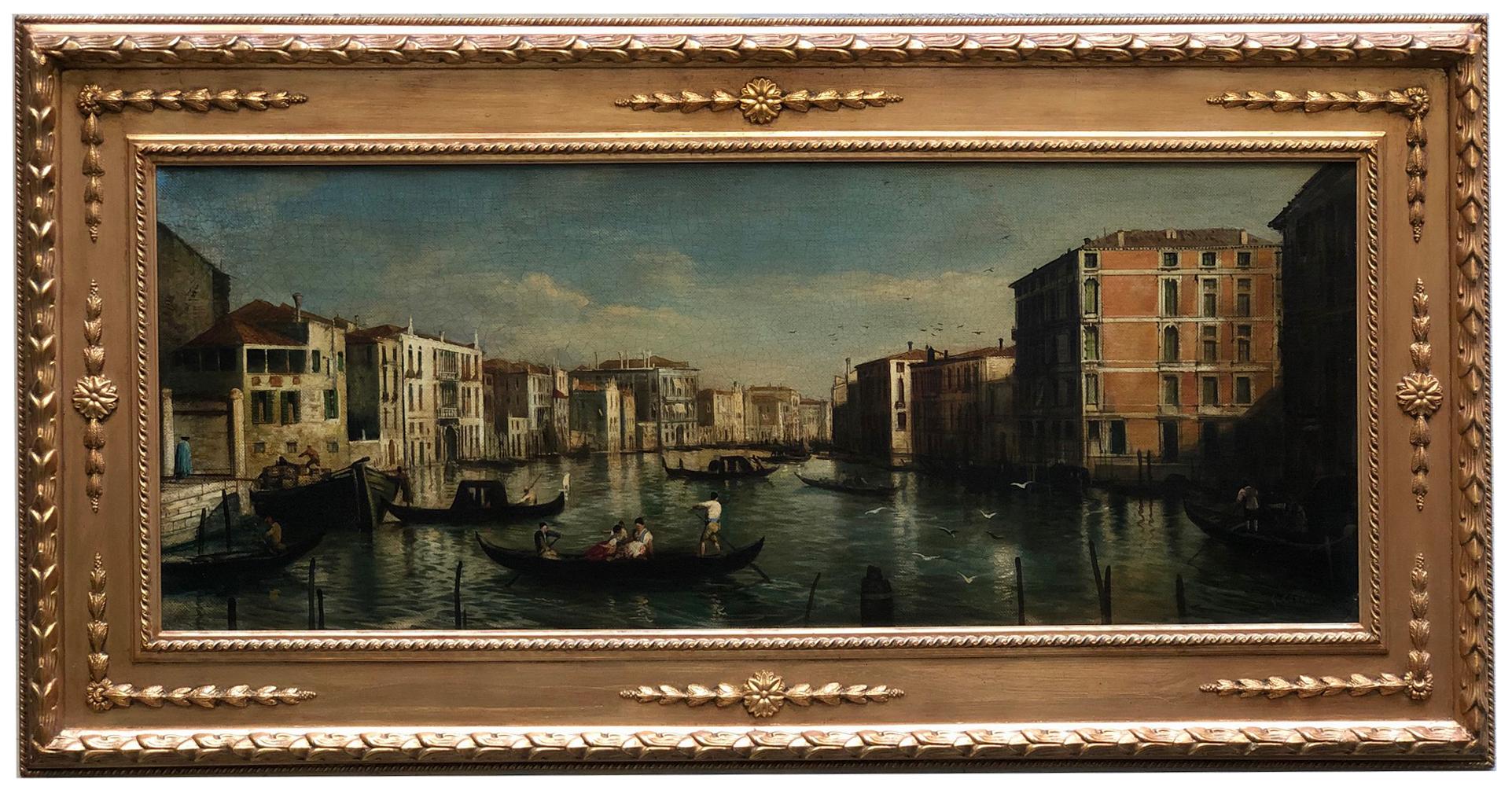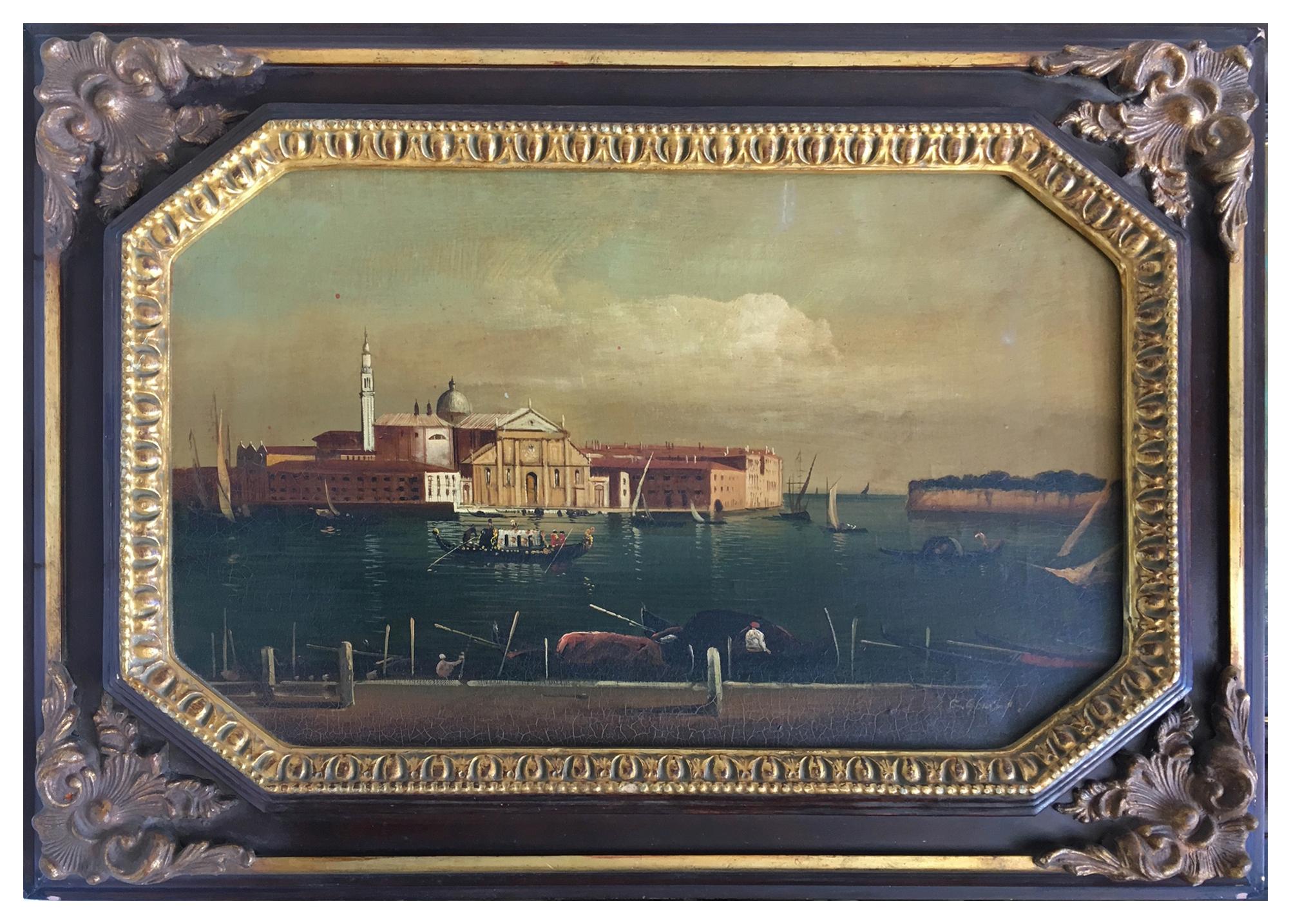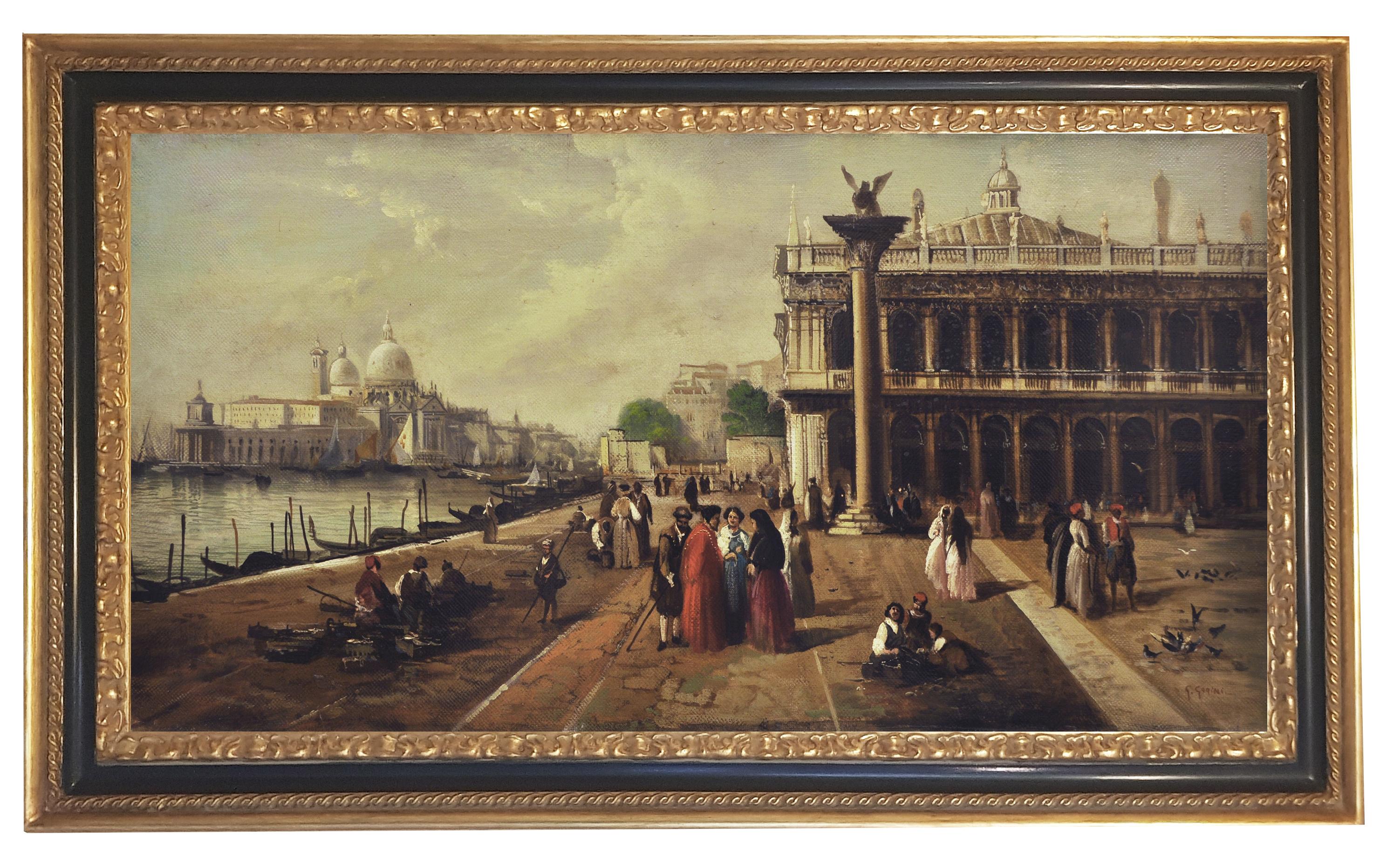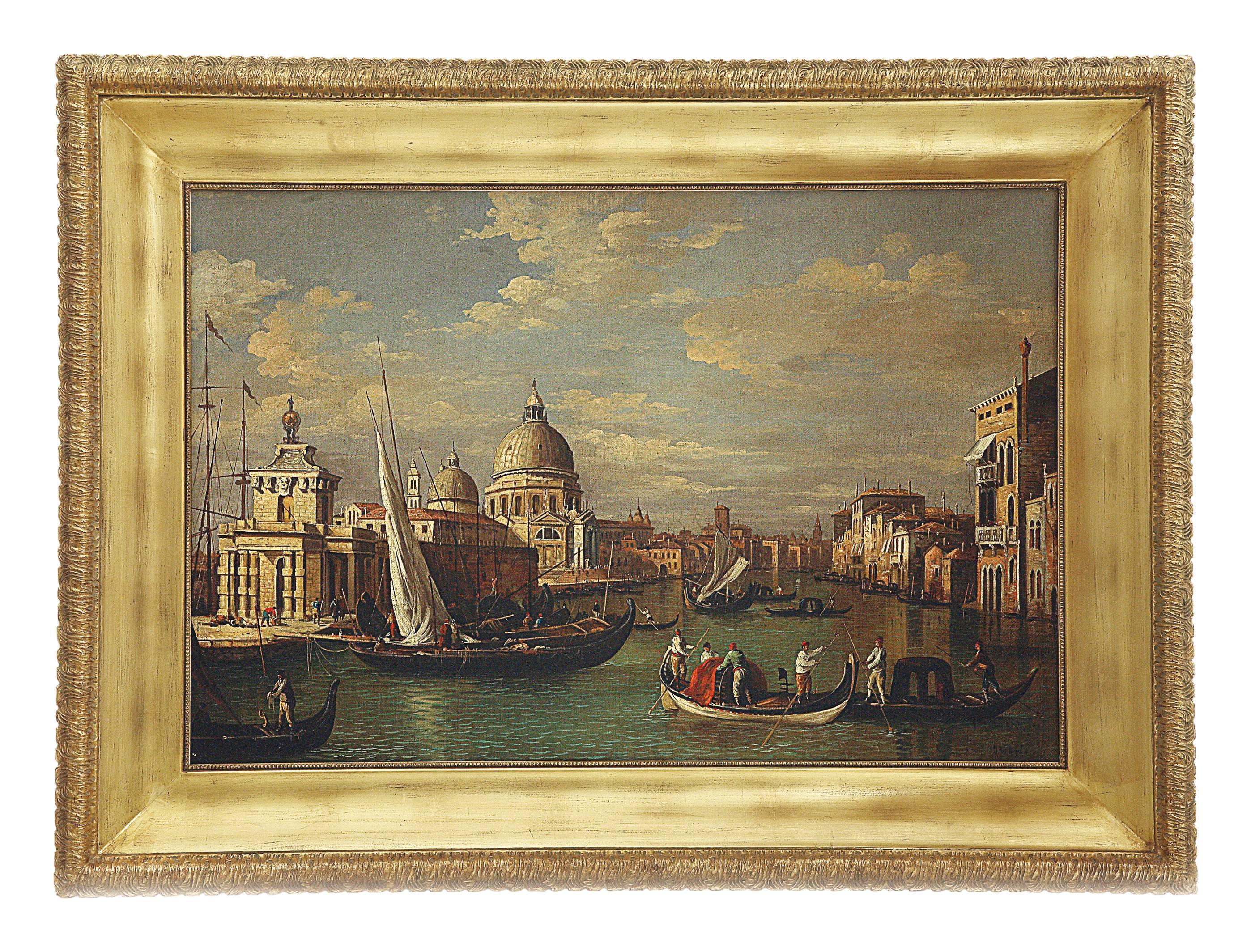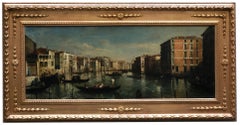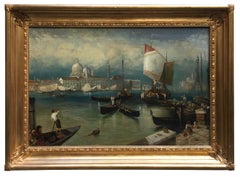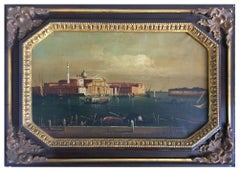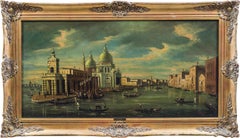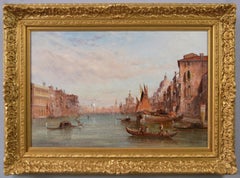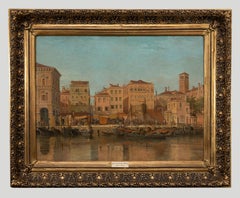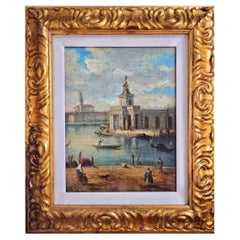Items Similar to VENICE - Gianluca Gorini - Italian Landscape Oil on Canvas Painting
Want more images or videos?
Request additional images or videos from the seller
1 of 15
Giancarlo GoriniVENICE - Gianluca Gorini - Italian Landscape Oil on Canvas Painting2002
2002
$4,178.18
£3,078.19
€3,500
CA$5,750.53
A$6,381.06
CHF 3,365.85
MX$77,899.15
NOK 42,584.64
SEK 39,883.96
DKK 26,642.23
About the Item
VENICE - Italian landscape oil on canvas oval painting cm.30x60 by Giancarlo Gorini, Italy 2002.
Gold gilded wooden frame available on request
Giancarlo Gorini's canvas is an extraordinary work of Italian landscape painting. It is inspired by the landscape painting of great Master Canaletto.
Gorini's paintings are a tribute to the city of Venice which thus becomes a spectacle of visible reality. Gorini's brushwork is precise, the touch is soft, the chromatic sense is accurate and varied. His painting creates excellent works, memories of precise places in beautiful Italy and at the same time memories of the heart.
- Creator:Giancarlo Gorini (1945 - 2008, Italian)
- Creation Year:2002
- Dimensions:Height: 11.82 in (30 cm)Width: 23.63 in (60 cm)
- Medium:
- Movement & Style:
- Period:
- Framing:Framing Options Available
- Condition:
- Gallery Location:Napoli, IT
- Reference Number:1stDibs: LU568311012592
About the Seller
4.8
Gold Seller
Premium sellers maintaining a 4.3+ rating and 24-hour response times
1stDibs seller since 2017
174 sales on 1stDibs
Typical response time: 1 hour
- ShippingRetrieving quote...Shipping from: Napoli, Italy
- Return Policy
Authenticity Guarantee
In the unlikely event there’s an issue with an item’s authenticity, contact us within 1 year for a full refund. DetailsMoney-Back Guarantee
If your item is not as described, is damaged in transit, or does not arrive, contact us within 7 days for a full refund. Details24-Hour Cancellation
You have a 24-hour grace period in which to reconsider your purchase, with no questions asked.Vetted Professional Sellers
Our world-class sellers must adhere to strict standards for service and quality, maintaining the integrity of our listings.Price-Match Guarantee
If you find that a seller listed the same item for a lower price elsewhere, we’ll match it.Trusted Global Delivery
Our best-in-class carrier network provides specialized shipping options worldwide, including custom delivery.More From This Seller
View AllVENICE - Italian Landscape Oil on Canvas Painting
By Giancarlo Gorini
Located in Napoli, IT
VENICE - Italian landscape oil on canvas oval painting cm.40x70 by Giancarlo Gorini, Italy 2002.
Giancarlo Gorini's canvas is an extra...
Category
Early 2000s Italian School Landscape Paintings
Materials
Canvas, Oil
VENICE - Giancarlo Gorini - Italian school - Oil on Canvas Landscape
By Giancarlo Gorini
Located in Napoli, IT
Venice - Giancarlo Gorini Italia 2002 - Oil on canvas cm.50x130
Giancarlo Gorini's canvas is an extraordinary work of Italian landscape painting. It is inspired by the paintings of ...
Category
Early 2000s Italian School Landscape Paintings
Materials
Canvas, Oil
VENICE- In the Manner of Canaletto - Oil On Canvas Italian Landscape Painting
By Giancarlo Gorini
Located in Napoli, IT
Venice - Giancarlo Gorini Italia 2004 - Oil on canvas cm.80x120
Giancarlo Gorini's canvas is an extraordinary work of Italian landscape painting. It is inspired by the landscape pai...
Category
Early 2000s Italian School Landscape Paintings
Materials
Canvas, Oil
VENICE - In the Manner of Canaletto - Italian Landscape Oil on Canvas Painting
By Giancarlo Gorini
Located in Napoli, IT
VENICE - Italian landscape oil on canvas painting cm.38x61 by Giancarlo Gorini, Italy 2006.
Giancarlo Gorini's canvas is an extraordinary work of Italian landscape painting. It is in...
Category
Early 2000s Italian School Landscape Paintings
Materials
Canvas, Oil
VENICE -In the Manner of Canaletto- Oil On Canvas Italian Landscape Painting
By Giancarlo Gorini
Located in Napoli, IT
Venice - Giancarlo Gorini Italia 2002 - Oil on canvas cm.50x100
Gold leaf gilded wooden frameavailable on request
Giancarlo Gorini's canvas is an extraordinary work of Italian lan...
Category
Early 2000s Old Masters Landscape Paintings
Materials
Canvas, Oil
VENICE -In the Manner of Canaletto- Italian Landscape Oil on Canvas Painting
By Mario De Angeli
Located in Napoli, IT
Venice - Mario De Angeli - Italia 2009 - Oil on canvas cm. 80x120.
Gold leaf gilded wooden frame ext. mis. cm.100x140
Mario De Angeli's canvas is an extraordinary work of Italian l...
Category
Early 2000s Old Masters Landscape Paintings
Materials
Gold Leaf
You May Also Like
Francesco Guarana (Venetian) - 19th/20th century landscape painting - Venice
Located in Varmo, IT
Francesco Guarana (active in Venice in the second half of the 19th century) - Venice, view of the beginning of the Grand Canal with the Basilica of S. Maria ...
Category
Late 19th Century Realist Landscape Paintings
Materials
Canvas, Oil
19th Century oil painting of The Dogana, Venice
By Alfred Pollentine
Located in Nr Broadway, Worcestershire
Alfred Pollentine
British, (1844-1910)
The Dogana, Venice
Oil on canvas, signed & further inscribed verso
Image size: 15.5 inches x 23.5 inches
Size including frame: 22.5 inches x 30.5 inches
A lovely painting of the Grand Canal, Venice towards the Punta Della Dogana by Alfred Pollentine. The view shows the entrance to the Grand Canal with the Dogana and Santa Maria Della Salute on the right.
Alfred William Pollentine was born in St Pancras, London on 26 August 1844, the son of William Pollentine, a carver gilder and picture dealer and Caroline Smith. After the death of his father in 1856, his mother married the artist Adam Barland...
Category
19th Century Landscape Paintings
Materials
Canvas, Oil
View of Venice - Oil on Canvas Late 19th Century
Located in Roma, IT
View of Venice is an original oil on canvas realized in the late 19th Century by a Master of Italian School.
On the reverse: label with inscribed “E. Mareis”
The painting represent...
Category
Late 19th Century Modern Figurative Paintings
Materials
Oil
Venice Dogana, Oil on Canvas, Venetian School, in style of Francesco Guardi
By Francesco Guardi
Located in Beograd, RS
In this listing you will find a painting done in style of Francesco Guardi Guardi. The painting depicts Dogana da Mar, located in Punta della Dogana - the triangular area of Venice, ...
Category
Antique 1810s Italian Paintings
Materials
Canvas, Wood
Venice The Lagoon, Painting 19th Century
By Alfred August Felix Bachman
Located in Saint-Ouen, FR
BACHMANN Alfred Félix August (1863-1956)
Venice Lagoon and Doge Palace
Oil on canvas signed Low Right
Frame gilded with leaves
Dim canvas : 73 X 54 cm Dim frame : 78 X 95 cm
...
Category
Late 19th Century Academic Landscape Paintings
Materials
Oil
Antique Oil on Canvas Painting of a Venetian Harbor
Located in Dallas, TX
Very fine antique painting of a busy Venetian harbor. Featuring beautiful architecture, boats, and figures. A wonderful piece of art! Circa 1920.
58w x 42h
Category
Early 20th Century Paintings and Screens
Materials
Canvas
$7,840 Sale Price
20% Off
More Ways To Browse
Oval Painting
Old Master Italian Landscape
Italian Old Masters Landscape Painting
Old Masters Venice
Old Masters Paintings In Gold Frames
Oval Landscape
Oval Oil Painting
Old Masters Paintings Of Venice
Oval Italian Painting
Oval Framed Landscapes
Oval Old Masters Paintings
Canaletto Oil
Vintage In Out Board
Landscape With Barn
Oil 1918
Boat Painting Large
Painting Of Edinburgh
Poppies And Painting
